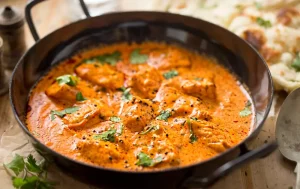Butter chicken, also known as Murgh Makhani, is a classic Indian dish beloved around the world. Originating from the Indian subcontinent, this dish features tender chicken pieces marinated in a mixture of yogurt and spices, then cooked in a creamy tomato-based sauce. The sauce is rich with butter and cream, giving the dish its characteristic smoothness and flavor.
The Origins of Butter Chicken
The creation of Butter Chicken dates back to the 1950s in Delhi, India. It was developed by chefs at the famous Moti Mahal restaurant as a way to utilize leftover tandoori chicken. By simmering these pieces in a creamy tomato gravy, they inadvertently created a dish that would become a global sensation. Its popularity lies in its ability to blend the smoky flavors of tandoori cooking with the rich, comforting textures of a creamy sauce.
Preparing the Chicken
The first step in making butter chicken involves marinating the chicken. Chefs typically use boneless chicken pieces, marinating them in a mixture of yogurt, lemon juice, garlic, ginger, and a blend of spices, including garam masala, cumin, and turmeric. This marination process not only flavors the chicken but also tenderizes it, ensuring it’s perfectly succulent once cooked.
Creating the Sauce
The sauce for butter chicken is what sets it apart from other dishes. It starts with frying onions, garlic, and ginger in butter until they are soft and fragrant. Tomatoes, often pureed, are then added along with more spices. The mixture simmers until thickened, at which point cream and butter are stirred in to create a rich and creamy sauce. Some recipes also include honey or sugar to balance the acidity of the tomatoes.
Cooking the Dish
After marinating, the chicken is grilled or roasted to add a smoky flavor. It’s then cut into pieces and added to the sauce, simmering together so the flavors meld. The dish is often finished with a touch of dried fenugreek leaves (kasuri methi) for an extra layer of flavor.
Serving Butter Chicken
Butter chicken is traditionally served with basmati rice or Indian breads like naan or roti. These accompaniments provide the perfect vehicle for savoring the creamy sauce. Garnishes might include fresh cilantro or a swirl of cream for presentation. This dish is not only a staple in Indian cuisine but has also won the hearts of people worldwide, making it a must-try for anyone looking to explore the rich flavors of Indian cooking.






